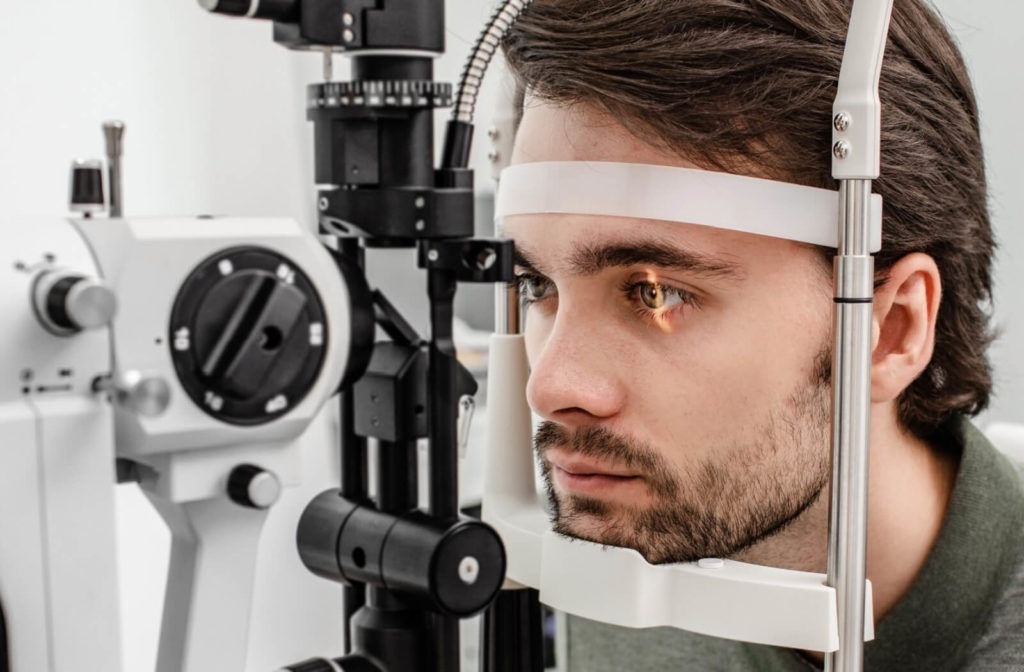Our eyes are incredibly complex and sensitive organs, and any discomfort or pain that might indicate an eye emergency can be quite distressing. One of the most unsettling sensations you can experience is a sharp stabbing pain in your eye.
This type of pain can vary in intensity and duration, but it’s important not to ignore it. Booking an eye exam is essential for discovering the reason behind any pain in your eye.
Some common causes of sharp eye pain include corneal abrasions, diseases and infections, and foreign objects that enter the eye. There are specific treatments available for each issue that help protect your eye and preserve your vision.
Corneal Abrasions
A corneal abrasion occurs when the outermost layer of the eye, the cornea, is scratched or damaged.
You may experience corneal abrasions for several reasons, including foreign objects like dust, sand, or even contact lenses. When a corneal abrasion occurs, it can lead to sharp, stabbing pain in the eye, along with other symptoms like redness, watery eyes, and sensitivity to light.
Treatment
Minor corneal abrasions often heal on their own within a couple of days. However, it’s still crucial to see an eye doctor. We may recommend lubricating eye drops or antibiotic ointments to aid the healing process. Avoid rubbing your eyes, as this can worsen the injury.
You may also need to avoid wearing contact lenses until your eyes have healed.
Conjunctivitis (Pink Eye)
Conjunctivitis, commonly known as pink eye, is an inflammation of the conjunctiva (the clear membrane covering the white part of the eye and the inside of the eyelids).
You may experience conjunctivitis because of viral or bacterial infections, allergies, or irritants. When you have conjunctivitis, sharp pain in the eye can occur alongside other symptoms such as redness, itching, and discharge. Sharp pain is often due to a bacterial infection.
Treatment
The treatment for conjunctivitis depends on the underlying cause. Viral pink eye usually clears up on its own, while bacterial conjunctivitis may require antibiotic eye drops.
Allergic conjunctivitis can be managed with antihistamine eye drops or oral medications. Avoiding irritants and maintaining good hygiene also helps prevent pink eye caused by allergies.
Foreign Object in the Eye
A foreign object, such as a tiny piece of metal, glass, an eyelash, or debris, can become lodged in the eye, leading to intense pain, pressure, and discomfort. The sensation of a sharp object in the eye can be distressing and may cause watery eyes and redness.
Treatment
If you suspect a foreign object is stuck in your eye, do not rub or press on your eye. Try to flush it out gently with clean, lukewarm water. If the object doesn’t come out or the pain persists, do not try to remove the foreign object yourself—seek immediate medical attention. An eye doctor can safely remove the object and assess any potential damage.
Corneal Ulcer
A corneal ulcer, also known as keratitis, is a severe and potentially sight-threatening condition. Keratitis can be caused by an infection, usually bacterial or fungal, and in some cases, extreme dry eye can cause keratitis.
The symptoms of keratitis include a sharp, stabbing pain in the eye, as well as white or grayish spots on the cornea, sensitivity to light, and blurred vision.
Treatment
Corneal ulcers require medical treatment, typically with antibiotic or antifungal eye drops or ointments. In severe cases, oral medications or even corneal transplant surgery may be necessary. Early intervention is crucial for preventing complications and preserving your vision.
Glaucoma
Glaucoma is a group of eye conditions often associated with increased pressure inside the eye, leading to damage to the optic nerve and potential vision loss.
Angle-Closure Glaucoma
While glaucoma is often a subtle condition that develops gradually with no symptoms, in some cases, it can develop rapidly and may be associated with a sharp pain in the eye. Those symptoms are often associated with angle-closure glaucoma.
Angle-closure glaucoma, also known as narrow-angle or acute glaucoma, is a serious condition that can cause intense eye pain, nausea, red eyes, and hazy vision.
The effects of angle-closure glaucoma are considered a medical emergency—you should seek out prompt emergency eye care or visit an emergency care center if you believe you’re experiencing angle-closure glaucoma.
Other Primary Glaucomas
Open-angle glaucoma: Open-angle glaucoma is the most prevalent type of glaucoma in the United States, with 9 out of 10 people who have glaucoma being affected by open-angle glaucoma.
Many people with open-angle glaucoma have no symptoms until they begin to lose their vision, and vision loss may not be noticed right away.
Experts aren’t sure about what causes open-angle glaucoma, but it could be a result of increased pressure in the eye. The pressure damages the optic nerve over time, affecting your vision. Open-angle glaucoma can lead to blindness if it’s not treated.
Normal-tension glaucoma: Normal-tension glaucoma is a form of glaucoma that affects individuals who have normal ocular pressure.
You may be more likely to develop normal-tension glaucoma if you have Japanese ancestry, have a history of normal-tension glaucoma in your family, or have experienced cardiac difficulties, such as an erratic heartbeat.
Congenital glaucoma: Congenital glaucoma occurs when a baby is born with an eye abnormality that prevents fluid from draining freely. Congenital glaucoma is extremely rare, affecting around 1 in every 10,000 babies born in the US.
Secondary Glaucomas
Neovascular glaucoma: Neovascular glaucoma develops when the eye produces extra blood vessels that cover the area of the eye where fluid normally drains. It is frequently the result of another medical disease, such as diabetes or high blood pressure.
Neovascular glaucoma is another form of glaucoma that may cause eye pain.
Pigmentary glaucoma: Pigmentary glaucoma can develop when the pigment (color) from your iris peels off and prevents fluid from moving out of your eye.
Pigmentary glaucoma is more common in young, caucasian men who are near-sighted. If you’re experiencing this condition, you might develop fuzzy vision or see rainbow-colored rings surrounding lights, particularly when exercising.
Exfoliation glaucoma: Exfoliation glaucoma is a kind of glaucoma that occurs in individuals with exfoliation syndrome, a condition where excess material deposits on parts of the eye and prevents fluid from escaping. If someone in your family has exfoliation glaucoma, you may be at a higher risk of developing it.
Uveitic glaucoma: People who have uveitis, a disorder that produces swelling and inflammation in the eye, are at risk of developing uveitic glaucoma. Uveitis can also cause eye pain.
Uveitic glaucoma affects about 2 in every 10 people who have uveitis. If you’re experiencing eye pain and swelling, it’s important to speak with your eye doctor.
Treatments for Glaucoma
Glaucoma treatments may involve medications to lower intraocular pressure and sometimes laser or surgical procedures to relieve the pressure. For some forms of glaucoma, treating another underlying condition may be the key to preserving your sight.
Routine eye exams are vital for diagnosing glaucoma and finding the correct treatment.

Speak with Your Eye Doctor About Eye Pain
Experiencing a sharp stabbing pain in the eye should never be taken lightly. Ignoring eye pain can lead to more serious complications and potential vision loss. If you encounter this kind of discomfort, it’s essential to seek a professional medical evaluation and prompt treatment.
The causes of eye pain can range from minor irritations to severe conditions, but with proper care and attention, many eye issues can be effectively managed to maintain the health and well-being of your eyes. At Dr. Henslick Vision Center, we’re ready to help protect your sight and help you get relief from eye pain. Book an appointment with us today!



